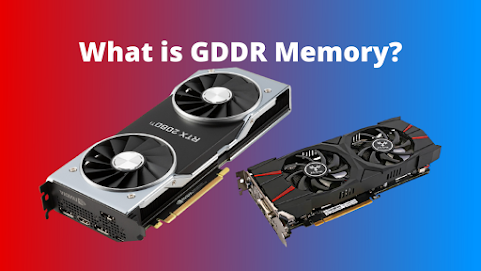Suppose you've never built or upgraded a gaming PC before things can get quite daunting once you start evaluating and comparing graphics cards after all graphics cards are a ton of specs that all sound is super important. The good thing is they aren't all that important at least not for gaming.
So,
it's better to focus on a couple of key specs and let the rest work itself out.
And one of the important graphics card specs is Video Memory. Most
graphics cards in 2020 utilize GDDR memory, but not all of them have the same
number affixed to them.
There's
GDDR5, GDDR6, GDDR6x that's why we'll be covering
everything you need to know about GDDR memory when picking out a graphics card
for a gaming PC.
What is GDDR?
We'll
start with the basics, and there's nothing more essential than understanding
what the acronym GDDR stands for.
Full Acronym
It
isn't even the full acronym GDDR SDRAM stands for Graphics Double Data Rate
Synchronous Dynamic Random-Access Memory. It is just a big mouthful
honestly thankfully there's no need to memorize this.
What's
good to know is that unlike your standard DDR SDRAM, GDDR SDRAM is designed and
optimized specifically for graphics processing tasks.
Different Iterations of Name
There
have been several iterations of GDDR RAM over the years. Initially, this
technology was called DDR SDRAM. Which stand for Double Data Rate
Synchronous Graphics Ram, but it was rebranded into GDDR SDRAM what
followed was GDDR2, GDDR3, GDDR4, GDDR5, GDDR5x, GDDR6, and finally GDDR6x in
this order.
Each
iteration was better than the last offering higher capacities, higher clock
speeds, higher data transfer rates and so on. In short, each new iteration of GDDR
RAM brought further improvements to the overall graphics performance.
So, what
type of GDDR RAM should you look for in a graphics card? Should you always get
the best one? Or is it okay to go with an older version?
Which version of GDDR
should you get?
Here's
the thing outside of a few very niche cases where a specific GPU was initially
released with one type of GDDR memory and later revamped and sold with another
you don't get to choose which GDDR RAM you get with which graphics card.
Choosing GDDR RAM With Which Graphics Card?
In 2020
nearly all the latest graphics cards utilize GDDR6 with only a couple of
high-end models like the RTX 3080 and the RTX 3090 featuring GDDR6x RAM with
its higher bandwidth and greater power efficiency. It's been some time since GDDR5
was the dominant type of video memory on the market. At the moment it is only
be found in graphics cards from a few years ago and some entry-level solutions
that aren't suited for gaming in 2020.
Overall Impact
So
overall it's not like you given much of a choice. Unless you're buying a used
graphics card, you're pretty much guaranteed to get one that equipped with GDDR6
VRAM. So, we've seen why you most likely won't get a say in deciding which
version of GDDR you'll get with your graphics card? However, this
doesn't mean you won't have to ask yourself some tough questions regarding VRAM.
That is,
How Much VRAM Do You Need?
In 2020,
the question of VRAM mostly has to do with the resolution you're planning to
game on. It isn't to say that there aren't other memory-intensive graphics
settings out there like textures and view distances, but the resolution is
easily the most significant factor right now.
VRAM And Resolutions
As
things stand, you'll need at least 4 gigabytes of VRAM for gaming in 1080p.
Anywhere between 6 and 8 gigabytes of VRAM for gaming in 1440p and at least 8
gigabytes of VRAM for gaming in 4k although you can never go wrong with more VRAM
when 4k gaming is concerned.
Getting Good Performance
You should
know that these are generalizations there's more to getting good performance than
just having plenty of VRAM. For example, the RX 570 GPU is a mid-range GPU
released back in 2017. Isn't fit for running games in 1440p? At least
not on a high graphic setting with reasonable frame rates. It is even though
the RX 570 can come with 8 gigabytes of VRAM. Nevertheless, this is still a
pretty good estimate that will hold for most graphic cards, especially newer
ones.
Are there other types of
VRAM?
Lastly,
we want to address the issue of using other types of VRAM instead of GDDR SDRAM.
HBM, which stands for High Bandwidth Memory, is another
increasingly popular type of VRAM. It far exceeds GDDR VRAM in many ways.
IS HBM Memory Is Fit for Modern Gaming graphics cards?
Although
this HBM memory is nowhere found in modern gaming graphics cards, why is this?
Well, the short of it is that this memory isn't fit for gaming. Instead, it is
best to use in workstations that can make use of its incredible specs. What you
need to know is that there is no reason whatsoever to get a graphics card with
HBM VRAM if you're just interested in gaming.
Conclusion
In conclusion, GDDR memory is a type of VRAM that can found in most gaming
graphics cards. At the moment GDDR6 is the most prevalent type of GDDR memory,
and you'd have to go out of your way to either purchase a super high-end
graphics card to get GDDR6x VRAM or a dated and likely used graphics card to
get GDDR5 VRAM.
For the
most part, how much VRAM you have should reflect? What resolution do you plan
to game on?
·
With 4 gigabytes is being incredible
for 1080p gaming.
·
6 to 8 gigabytes being good for 1440p
gaming.
·
And 8 gigabytes and beyond being
necessary for 4k gaming.
